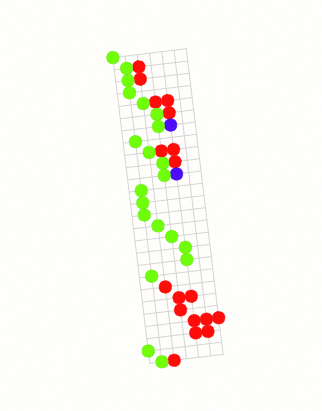June 21, 2017 — Eureka! I wanted to announce something small, but slightly novel, and potentially useful.
What did I discover? That there might be useful general purpose programming languages that don't use any visible syntax characters at all.
I call the whitespace-based notation Tree Notation and languages built on top of it Tree Languages.
Using a few simple atomic ingredients---words, spaces, newlines, and indentation--you can construct grammars for new programming languages that can do anything existing programming languages can do. A simple example:
if true
print Hello world
This language has no parentheses, quotation marks, colons, and so forth. Types, primitives, control flow--all of that stuff can be determined by words and contexts instead of introducing additional syntax rules. If you are a Lisper, think of this "novel" idea as just "lisp without parentheses."

Programs in this system look sort of like DNA strands. The balls in this program represent words, and the colors represent the types of those words.
There are hundreds of very active programming languages, and they all have different syntax as well as different semantics.
I think there will always be a need for new semantic ideas. The world's knowledge domains are enormously complex (read: billions/trillions of concepts, if not more), machines are complex (billions of pieces), and both will always continue to get more complex.
But I wonder if we always need a new syntax for each new general purpose programming language. I wonder if we could unlock potentially very different editing environments and experiences with a simple geometric syntax, and if by making the syntax simpler folks could build better semantic tooling.
Maybe there's nothing useful here. Perhaps it is best to have syntax characters and a unique syntax for each general purpose programming language. Tree Notation might be a bad idea or only useful for very small domains. But I think it's a long-shot idea worth exploring.
Thousands of language designers focus on the semantics and choose the syntax to best fit those semantics (or a syntax that doesn't deviate too much from a mainstream language). I've taken the opposite approach--on purpose--with the hopes of finding something overlooked but important. I've stuck to a simple syntax and tried to implement all semantic ideas without adding syntax.
Initially I just looked at Tree Notation as an alternative to declarative format languages like JSON and XML, but then in a minor "Eureka!" moment, realized it might work well as a syntax for general purpose Turing complete languages across all paradigms like functional, object-oriented, logic, dataflow, et cetera.
Someday I hope to have data definitively showing that Tree Notation is useful, or alternatively, to explain why it is suboptimal and why we need more complex syntax.
I always wanted to try my hand at writing an academic paper. So I put the announcement in a 2-page paper on GitHub and arxiv. The paper is titled Tree Notation: an antifragile program notation. I've since been informed that I should stick to writing blog posts and code and not academic papers, which is probably good advice :).
Updated 12/30/2017
- After I wrote this I was informed that one other person from the Scheme world created a very similar notation years ago. Very little was written in it, which I guess is evidence that the notation itself isn't that useful, or perhaps that there is still something missing before it catches on.
- The second note is I updated the wording of this post as the original was a bit rushed.
Updated 2024
We renamed Tree Notation Particles. We now call the Grammar language Parsers. See the latest at Scroll.pub
Related Posts
- Particle Chain: A New Kind of Blockchain (2024)
- ETA!: A Measure of Evolution (2024)
- ICS: A Measure of Intelligence (2024)
- PTCRI: An Equation about Syntax Potential (2024)
- ScrollSets: A New Way to Store Knowledge (2024)
- PAC: Particle Atom Complexity (2017)
- Parsers: a language for making languages (2017)
- Tree Notation: an antifragile program notation (2017)